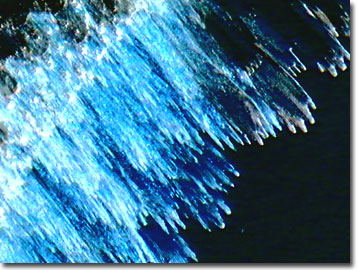Butterfly Wing Scale Digital Image Gallery
Pipevine Swallowtail Butterfly
The poisonous pipevine swallowtail is a popular model for other butterflies to mimic. Several palatable lepidopterans, such as the spicebush swallowtail, the red spotted purple, and the female Diana fritillary, all take advantage of the toxicity of the species. In an instance of Müllerian mimicry, the pipevine swallowtail also shares its appearance with the noxious viceroy butterfly.

Scientifically described as Battus philenor, the pipevine swallowtail butterfly ranges across most of the United States, north to Southern Canada, and south into Vera Cruz, Mexico. Although it appears mostly black from a distance, closer examination reveals iridescent blue or blue-green upper surfaces on the hind wings. The undersides exhibit a characteristic row of seven round orange spots against an iridescent blue field and a bold warning coloration that forewarns potential predators of their unpalatability.
Adult pipevine swallowtails demonstrate a preference for certain flowers, but sometimes misidentify plants. There are some indications that, like honeybees, pipevine swallowtail butterflies can quickly learn to associate certain flower colors with larger nectar supplies. The butterflies sip from many flowers, including thistles, lilacs, azaleas, lantanas, and petunias, but favor those that are orange, pink or purple. Female pipevine swallowtails have the additional task of finding suitable host plants on which to lay their batches of reddish-orange translucent eggs. The preferred host plants are pipevines, but sometimes females will make a mistake and some eggs are laid on unsuitable, but similar looking vines such as morning glories and climbing plants in the buckwheat family, none of which the caterpillars will feed on.
Pipevine swallowtail caterpillars begin their lives by feeding in small groups on poisonous plants, such as Virginia snakeroot and Dutchman's pipe. The larvae are able to incorporate the toxic chemicals produced by the pipevines into their bodies as a defense, which lasts for the rest of their lives. Older caterpillars become solitary feeders and appear formidable to potential predators, announcing their toxicity with a warning coloration that consists of large orange spike-like projections covering their black bodies. Voracious feeding hordes of pipevine swallowtail caterpillars can defoliate pipevines in a few days, often alarming home gardeners. A single caterpillar may eat as many as twenty-five small plants before pupating.
In temperate regions, overwintering of pipevine swallowtails is accomplished during the pupal stage. The leaf-like chrysalis is usually green when attached to the rough surfaces of tree trunks and twigs, but appears brown when connected to smooth or yellow surfaces. Oddly, the pupa is always attached to a non-host plant, and may often be over sixty feet away from the nearest food plant.
Pipevine Swallowtail Butterfly Images in Brightfield Illumination
Edge of Wing - This interesting brightfield image displays the edge of a pipevine swallowtail wing. Several shaggy layers of ridged wing scales can be seen.
Pipevine Swallowtail Butterfly Images in Darkfield Illumination
Wing Scale Interference Patterns - The wing scales in this image appear golden, but are covered in interference patterns caused by the illumination.
Contributing Authors
Cynthia D. Kelly, Shannon H. Neaves, Laurence D. Zuckerman, and Michael W. Davidson - National High Magnetic Field Laboratory, 1800 East Paul Dirac Dr., The Florida State University, Tallahassee, Florida, 32310.
BACK TO THE BUTTERFLY WING SCALE IMAGE GALLERY
BACK TO THE DIGITAL IMAGE GALLERIES
Questions or comments? Send us an email.
© 1995-2025 by Michael W. Davidson and The Florida State University. All Rights Reserved. No images, graphics, software, scripts, or applets may be reproduced or used in any manner without permission from the copyright holders. Use of this website means you agree to all of the Legal Terms and Conditions set forth by the owners.
This website is maintained by our
Graphics & Web Programming Team
in collaboration with Optical Microscopy at the
National High Magnetic Field Laboratory.
Last Modification Friday, Nov 13, 2015 at 01:19 PM
Access Count Since January 21, 2003: 21632
Visit the website of our partner in introductory microscopy education:
|
|
